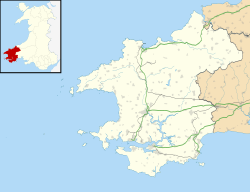| Liddeston | |
|---|---|
Location within Pembrokeshire | |
| OS grid reference | SM895068 |
| Community | |
| Principal area | |
| Preserved county | |
| Country | Wales |
| Sovereign state | United Kingdom |
| Post town | MILFORD HAVEN |
| Postcode district | SA73 |
| Dialling code | 01646 |
| Police | Dyfed-Powys |
| Fire | Mid and West Wales |
| Ambulance | Welsh |
| UK Parliament | |
| Senedd Cymru – Welsh Parliament | |

Liddeston is a small coastal village in Pembrokeshire, Wales. It belongs to the Milford North ward of the community of Milford Haven [1] in the historical hundred of Roose. It is located to the north of the town of Milford Haven and the village of Hubberston.
